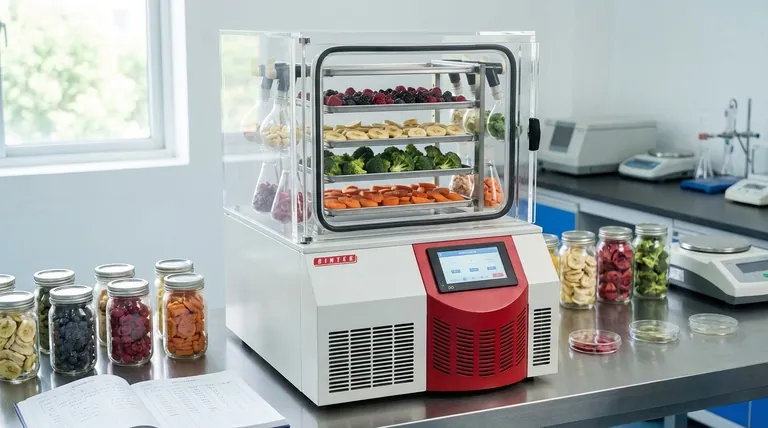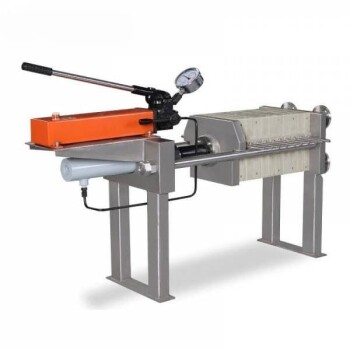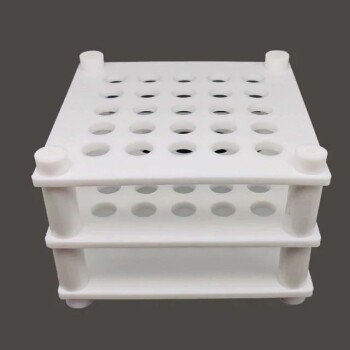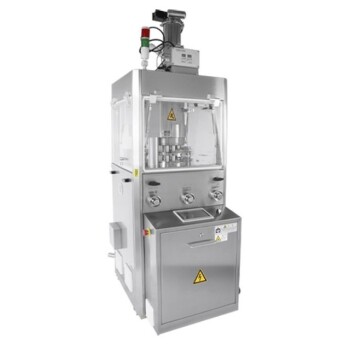At its core, freeze drying is an exceptional method for preserving fruits and vegetables because it removes water while leaving nearly everything else—nutrients, flavor, color, and structure—remarkably intact. This process, known as lyophilization, involves freezing the produce and then placing it in a strong vacuum, which turns the ice directly into vapor without it ever becoming liquid. The result is a lightweight, shelf-stable product with a vastly extended shelf life that requires no refrigeration or chemical preservatives.
The crucial advantage of freeze drying is its ability to bypass the destructive effects of heat and liquid water removal. This preserves the food's nutritional and structural integrity in a way that conventional drying, canning, or freezing cannot match.

How Freeze Drying Protects Food Quality
The unique mechanism of freeze drying is what sets it apart from all other preservation methods. It works by gently removing water while leaving the food's delicate architecture in place.
The Principle of Sublimation
The process begins by freezing the fruit or vegetable solid. It is then placed under a deep vacuum.
This vacuum environment allows the frozen water crystals to turn directly from a solid (ice) into a gas (water vapor), completely skipping the liquid phase. This process is called sublimation.
Because liquid water is never present to wash away nutrients or collapse the food's cellular walls, the final product is a near-perfect snapshot of its fresh state.
Preserving Nutritional Value
Conventional drying methods rely on heat to evaporate water. This heat can degrade or destroy sensitive vitamins and nutrients, such as Vitamin C and A.
Freeze drying, by contrast, is a low-temperature process. This minimal heat exposure means the vast majority of the original vitamins, minerals, and antioxidants are retained.
Maintaining Structural Integrity
When food is dehydrated with heat, the removal of liquid water causes the cell structure to collapse and shrink, resulting in a dense, leathery texture.
Freeze drying preserves the original physical structure. The space once occupied by ice crystals becomes a network of tiny, empty pores, leaving the food's shape, size, and texture largely unchanged. This is why freeze-dried food rehydrates so effectively.
The Practical Advantages of Freeze-Dried Foods
Beyond nutritional quality, freeze-dried produce offers significant logistical and practical benefits.
Extended Shelf Life Without Refrigeration
Spoilage is primarily caused by microorganisms like bacteria and mold, which require water to grow.
By removing up to 99% of the water content, freeze drying effectively halts all biological activity. This gives the food an incredibly long shelf life—often 25 years or more—without needing refrigeration or preservatives.
Significant Weight Reduction
Water is heavy. Removing it from fruits and vegetables reduces their weight by as much as 90%.
This makes freeze-dried foods extremely lightweight and compact, which is ideal for hiking, emergency preparedness kits, and reducing shipping costs.
Easy Reconstitution
Because the food's porous structure is preserved, water can easily travel back into it.
Simply adding water allows freeze-dried fruits and vegetables to quickly return to a state that is remarkably close to their original texture, flavor, and appearance.
Understanding the Trade-offs
While freeze drying offers superior results, it is not without its limitations. Objectivity requires acknowledging them.
High Initial Cost
Freeze-drying equipment is significantly more complex and expensive than a standard food dehydrator or canning equipment. This initial investment can be a substantial barrier for home use or small-scale production.
Long and Energy-Intensive Process
A typical freeze-drying cycle can take 24 to 48 hours to complete. This is far slower and consumes more energy than conventional drying methods, which can be finished in a matter of hours.
Fragility of the Final Product
The preserved porous structure that allows for easy rehydration also makes the final product very brittle and fragile. Freeze-dried foods must be packaged carefully to protect them from being crushed into powder.
Making the Right Choice for Your Goal
Deciding on a preservation method depends entirely on your priorities.
- If your primary focus is maximum nutritional retention: Freeze drying is the unparalleled choice, as it avoids the heat that destroys vitamins and minerals in other methods.
- If your primary focus is long-term, shelf-stable storage: The near-total water removal makes freeze-dried food the gold standard for creating a food supply that lasts for decades without refrigeration.
- If your primary focus is preserving original taste and texture: Freeze drying excels at maintaining the food's structure, allowing it to rehydrate to a state very close to its fresh form.
- If your primary focus is cost and speed: Conventional dehydration, canning, or freezing are far more practical and accessible options for everyday food preservation.
Ultimately, freeze drying provides the highest-quality preserved food by fundamentally changing the physics of water removal.
Summary Table:
| Key Benefit | Description |
|---|---|
| Nutrient Retention | Low-temperature process preserves vitamins and antioxidants lost in heat-based drying. |
| Structural Integrity | Maintains original shape and texture, allowing for quick and effective rehydration. |
| Extended Shelf Life | Up to 25+ years without refrigeration by removing up to 99% of water. |
| Weight & Space Saving | Reduces weight by up to 90%, ideal for storage and transport. |
Ready to achieve the highest standard in food preservation?
KINTEK specializes in providing reliable laboratory equipment, including freeze dryers, to help you preserve the nutritional value, flavor, and structure of your fruits, vegetables, and other sensitive materials. Our solutions are designed for researchers and producers who demand precision and quality.
Contact our experts today via our Contact Form to find the perfect freeze-drying solution for your laboratory's needs and discover how we can support your preservation goals.
Visual Guide

Related Products
- Benchtop Laboratory Freeze Dryer for Lab Use
- Benchtop Laboratory Vacuum Freeze Dryer
- Laboratory Sterilizer Lab Autoclave Pulse Vacuum Lifting Sterilizer
- Laboratory Sterilizer Lab Autoclave Vertical Pressure Steam Sterilizer for Liquid Crystal Display Automatic Type
- Laboratory Test Sieves and Sieving Machines
People Also Ask
- What is the purpose of laboratory freeze drying? Preserve Sensitive Drugs & Biologics for Stability
- What role does freeze drying play in scientific research? Preserve Sample Integrity for Reliable Results
- What are the main steps involved in the freeze-drying process? A Guide to the 3 Key Stages
- What role do laboratory freeze dryers play in the food industry? Unlock Superior Food Preservation
- Why is freeze drying considered more effective than ordinary drying? Preserve Structure, Nutrients & Flavor



















